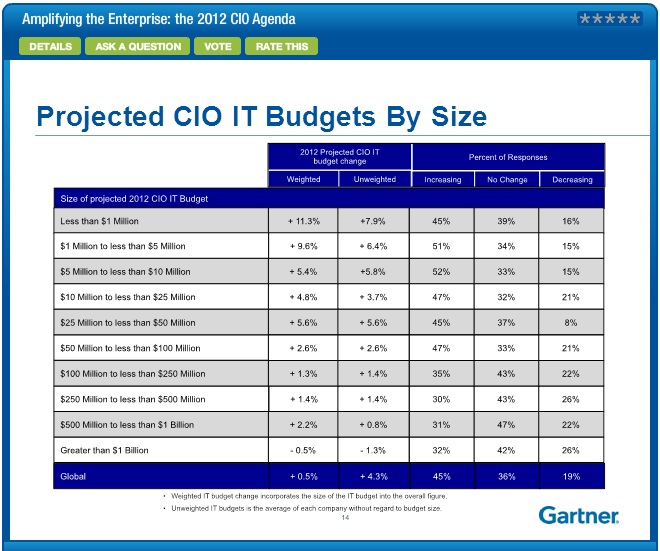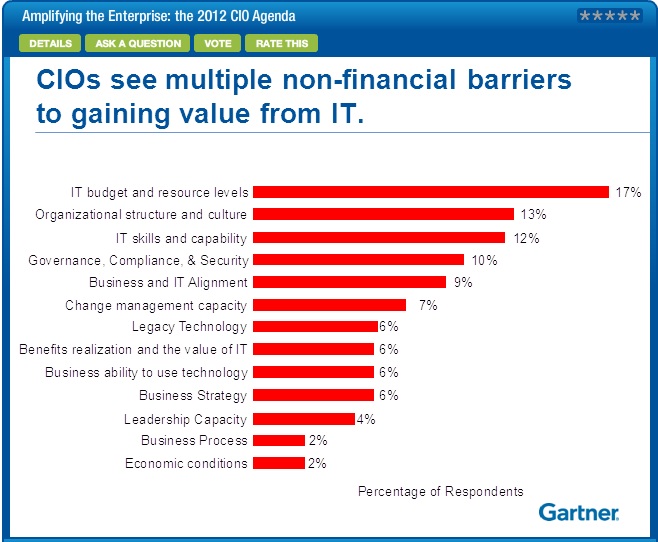CIOs need to treat enterprise IT less like a series of violins and more like a well-played tuba if they want to create more value for their organizations, a Gartner analyst told a Webcast audience on Thursday.
The market research firm hosted an online session to go over the results of its most recent survey of chief information officers, which gathers responses from 2,335 CIOs, representing more than $321 billion in CIO IT budgets and covering 37 industries in 45 countries. According to Mark McDonald, group vice-president for Gartner Executive Programs and a Gartner Fellow, the message that came out of the data was clear. After years of trying to align IT with the business and then, more recently, focusing on cost-cutting and efficiency, now is the time for CIOs to “amplify the business” by focusing on improving customer experiences and eliminating internal factors that block their chances of success.
McDonald used musical instruments as metaphors to explain the point further. “Consider the violin. It’s a very beautiful instrument. But if you want to make the sound of the violin bigger, the traditional approach to do that is to replicate the number of violins playing,” he said. This is “amplification by replication,” McDonald explained, and many CIOs have taken a similar approach with IT. In other words, they have responded to business needs by adding layer upon layer of technology. “As you do that, however, you start to see additional coordination costs, overhang from legacy systems, core rigidities.”
While 80 per cent of the musicians in most orchestras are playing the strings, however, McDonald pointed to the lone tuba player who is easily heard by the audience. However, “Just being loud isn’t good,” McDonald added. Instead, CIOs need to take the signals they get from the business about what they want from IT and use analytics and other tools to gauge feedback on what IT departments do. “You need to match the note and provide fidelity,” he said.
According to the Gartner CIO study, for most chief information officers the key signals being sent their way by management continues to focus on three areas. These include growing the business, attracting and retaining customers and keeping costs down. Gartner is recommending a greater focus on the customer experience, which McDonald suggested should be less about how easy IT systems are to use and more about how easy IT departments are to work with other business units.
“Unfortunately, IT budgets do not support CIOs in such a way that they can invest their way to success,” McDonald said. In fact, based on Gartner’s research, the larger the IT budget in the organization the more likely it is to face cuts.

Beyond those challenges, CIOs also told Gartner they see non-financial barriers around changing organizational culture, filling in gaps within staff skill sets and dealing with governance issues. This makes it more important than ever for IT decision makers to keep in mind the other ingredient, besides signals and feedback, that make amplification possible: eliminating distortion.
“These are the things that create costs, that create complexity . . . you need to eliminate these internally,” he said. “That will be the dominant thing many of us will do in 2012.”

Technologies that CIOs see themselves using to amplify the business include analytics, mobility and the cloud, according to the Gartner survey. McDonald said the idea of using business intelligence to gather massive amounts of information, dumping it in a data warehousing and extracting insights is losing favour, however. Instead, he predicted the rise of analytic point solutions where BI was paired with mobility, supply chain and social technologies.
Mobility innovations, meanwhile, will be driven largely by firms’ desire to be leaders in their respective industries.
“It’s going to be qualitatively different because executives can demo to other executives. Business leaders can now benchmark themselves against their peers in a way they never have before,” he said. “A CEO or a CFO would look foolish saying, ‘My ERP is better than your ERP.’ But imagine executives showing off their apps . . . executive envy is going to be a significant factor driving mobile solutions.”
McDonald said the survey revealed 76 per cent of CIOs say they always use performance against budgets and cost as a key metric, along with service availability at 77 per cent. He offered three other key questions, however, they could use to evaluate their contribution to the organization:
· Does the IT strategy allow the organization to execute their business strategy at a fast speed?
· How can CIOs drive scale effectively by leveraging applications and infrastructure to support the business strategy?
· Does the business strategy open, close or “brick over” IT strategy options?